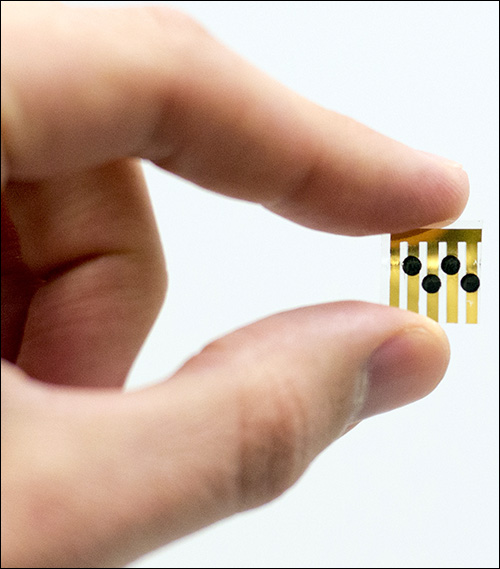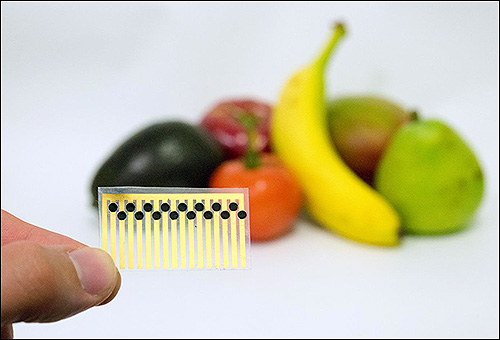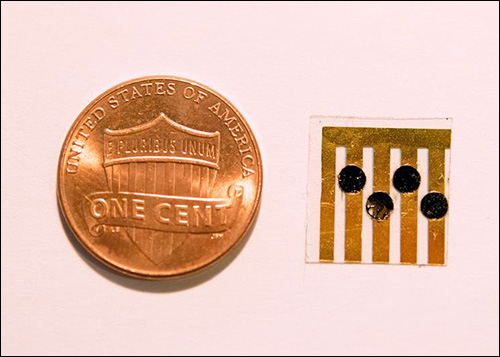C2Sense, a sensor and radio frequency identification technology startup located in Cambridge, Mass., is preparing several pilots that will test the sensor technology it has developed—in RFID-enabled packaging, as well as in ID badges—to wirelessly detect and transmit the presence of specific gases that would require some action be taken.
This year, a company that does not want to be publicly identified is testing the sensors without RFID to monitor temperatures in a perishable food-storage environment. Later this year, a firm that makes packaging material for meat and seafood will launch a project with C2Sense to test the technology’s ability to monitor for the presence of sulfides and biogenic amines inside packages of meat via RFID.
Next year, C2Sense reports, the U.S. Department of Energy (DOE) will begin testing the technology with ultrahigh-frequency (UHF) RFID-enabled sensors built into disposable ID badges. Handheld UHF readers will be used to track the presence of ammonia, which would indicate a possible leak of toxic chemicals that could pose a threat to workers. The company expects to launch its RFID-enabled sensors commercially following the conclusion of these pilots.
C2Sense was founded by Timothy M. Swager, a chemistry professor at the Massachusetts Institute of Technology (MIT), and researcher Jan M. Schnorr, C2Sense’s CEO, who want to commercialize the technology they developed in the MIT lab. The system consists of material built into chemically actuated resonant devices (CARDs) that alter the way in which a signal is transferred from a Near Field Communication (NFC) or RFID tag to a reader (by either enabling or reducing the RF transmission), or from one electrode to another, thereby signaling the presence of a specific gas.
It all began as a university project, Schnorr says, in which researchers asked themselves “What is the simplest way to take real-world [gas detection] information into the digital world?” Most sensor devices, he explains, are immobile, expensive and thus not used at most locations where the presence of gas could indicate a problem with a product, or a hazard for human health. Therefore, goods in the supply chain, as well as the conditions under which people work, are often untested for gases.
“Our group, for many years, has focused on chemical sensing,” Swager says, “creating ways to recognize particular chemicals or classes of chemicals,” and to convert that sensor data for users.
Initially, the researchers focused on the detection of ethylene, which is emitted from spoiling fruits and vegetables. By inserting carbon nanotubes using CARD material into a standard NFC tag, the researchers found that they could signal the presence of ethylene (see RFID Goes Bananas).
Even before the team tried the nanotube CARD on an NFC tag, Schnorr says, the solution proved to affect the transfer of an electrical current from one electrode to another, based on the presence of a particular gas. Therefore, he adds, the technology can work even without RFID.
The advantage to using NFC or RFID technology, however, is the ability to power the sensor and collect data via a mobile phone (in the case of NFC) or a reader (in the case of UHF RFID).
In some cases, Schnorr says, users prefer UHF RFID for the long-range transmission it enables, while NFC is preferable in scenarios in which users may collect data via a mobile phone. UHF RFID could enable the reading of sensor tags, for instance, on a carton of products travelling on a forklift through a dock door with a fixed RFID reader. Anyone equipped with an NFC reader built into their smartphone could use NFC technology, including a consumer who purchased a product.
C2Sense, Swager says, “has established a broad class of materials based on nanotubes” that can change their resistance in response to the detection of a specified type of gas. The latest CARD sensor technology comes in the form of a nanotube that normally is highly conductive but has been wrapped in an insulating material that blocks RFID transmission. When exposed to specific gases, this material breaks apart and the nanotubes become conductive enough to enable a tag to be read.
The sensors are sufficiently sensitive to detect less than 10 parts per million of target toxic gases within about five seconds. (In some cases, the company reports, its sensors have achieved detection rates of 100 parts per billion.) The initial tags would indicate a chemical’s presence by simply being turned on or off (an RFID transmission would indicate whether or not the chemical was present). However, Schnorr says, the firm is currently working on a version of the NFC or RFID tag that would not only turn a transmission on or off, but also detect the presence and volume of a gas, and then transmit that data to a reader so that individuals could know that a gas was present, and in what quantity. In that way, those in an industrial environment could know the level of toxic gas to which they have been exposed, while in the case of fresh foods, consumers or retailers could know how soon a product might go bad.
C2Sense is working with multiple NFC and UHF RFID chips, including products from Norway’s Thinfilm and Germany’s ams AG.
The pilot taking place this month will not use RFID technology. Instead, the C2Sense sensor consists of material that changes resistance based on the presence of chemicals, as well as electrodes. A cabled connection between the device and a computer forwards the data to a cloud-based server.
NFC and RFID technologies were not required in this instance, Schnorr says, since the unnamed food-storage company will be testing conditions within a large storage area and does not need the devices to move with a product, such as might be necessary in a food supply chain.
Later this year, however, a packaging company, which has also asked to remain unnamed, will be piloting either a UHF RFID or NFC version of the technology with fresh meat, fish and poultry packaging. In this case, the tags would transmit a unique ID number to an interrogator with the transmission turned on or off, depending on the presence of sulfide or another compound that would indicate the product was beginning to spoil. Meat lends itself well to the technology, Schnorr notes, for several reasons. It is more difficult to visually identify when meat is beginning to spoil than it is with fruits or vegetables, he explains, and the high value of meat makes it more desirable to prevent any spoiling.
While C2Sense wants to pilot the prototype sensor tag throughout the supply chain, from meat producer to consumer, the initial phase will test the technology only in parts of the supply chain—for instance, as goods are received or moved through a distribution center or at a retail location. The company will provide the software that manages the collected read data on a cloud-based server, as well as an app (in the case of NFC tag reads on phones), either through its own development, or through work with a software-providing partner. “It’s important that we provide full solutions,” Schnorr states.
In addition, the company is working with the Department of Energy to create a prototype hazard-detection badge that will be tested by employees at the Hanford Site, in the state of Washington, where former nuclear production clean-up is currently under way. The state’s attorney general filed a lawsuit against the DOE when workers were sickened by a release of toxic gases last year, and the federal agency is now looking into technology that would help identify when such gases are present while employees are onsite.
The solution from C2Sense is the UHF RFID version of the company’s technology, in the form factor of an adhesive, disposable badge. Each badge has a unique ID number that it transmits, as well as a built-in CARD sensor to detect the presence of ammonia, which would indicate a toxic gas release. The badges would either transmit a signal to handheld UHF RFID readers that could be connected to a worker’s cell phone, or transmit the data to the phone via a Bluetooth connection.
“Between the MIT lab and C2Sense,” Schnorr states, “we have become very good at developing sensors for specific use cases.”
The sensor technology is designed to be low-cost, easy to use and disposable, Schnorr says. He envisions the system being used in fresh food supply chains, as well as at any location where workers could be exposed to chemical fumes. Such individuals include research lab personnel, firefighters, miners, oil-exploration workers and gas station attendants.






